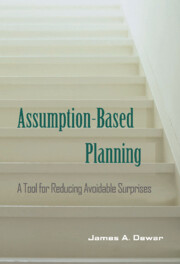Book contents
- Frontmatter
- Contents
- Figures
- Preface
- Acknowledgments
- 1 The essence of Assumption-Based Planning
- 2 A taxonomy of assumptions
- 3 Step 1: identifying assumptions
- 4 Step 2: identifying load-bearing, vulnerable assumptions
- 5 Step 3: identifying signposts
- 6 Step 4: developing shaping actions
- 7 Step 5: developing hedging actions
- 8 The art of conducting ABP
- 9 Beyond ABP as a post-planning tool
- Appendix: Assumption-Based Planning and the planning literature
- Bibliography
- Glossary
- Index
2 - A taxonomy of assumptions
Published online by Cambridge University Press: 29 October 2009
- Frontmatter
- Contents
- Figures
- Preface
- Acknowledgments
- 1 The essence of Assumption-Based Planning
- 2 A taxonomy of assumptions
- 3 Step 1: identifying assumptions
- 4 Step 2: identifying load-bearing, vulnerable assumptions
- 5 Step 3: identifying signposts
- 6 Step 4: developing shaping actions
- 7 Step 5: developing hedging actions
- 8 The art of conducting ABP
- 9 Beyond ABP as a post-planning tool
- Appendix: Assumption-Based Planning and the planning literature
- Bibliography
- Glossary
- Index
Summary
A primary aim of Assumption-Based Planning is to identify certain types of assumptions underlying a plan: those that are load-bearing and vulnerable. This suggests that there are different kinds of assumptions. Indeed, we have found it useful to distinguish among several different types. In addition to making clear exactly what we mean in general by assumption, it is also important to make the distinctions among the different types of assumptions clear.
Webster's New World Dictionary defines assumption as “the supposition that something is true” or “a fact or statement taken for granted.” (The 1998 version defines assumption as “an assuming that something is true.”) The assumptions we are interested in fit these definitions, but they are more restricted. We are interested only in planning assumptions. For ease of discussion, we drop the planning, but it is implicit in what we have come to mean by “assumption” in Assumption- Based Planning:
A [planning] assumption is a judgment or evaluation about some characteristic of the future that underlies the plans of an organization.
All planning requires some judgments about, or evaluations of, the future. The more uncertain the future, the more likely it is that the planner will have to make judgments or “guesstimates” to help narrow the range and number of uncertainties about the future into a manageable few before progress can be made.
- Type
- Chapter
- Information
- Assumption-Based PlanningA Tool for Reducing Avoidable Surprises, pp. 14 - 31Publisher: Cambridge University PressPrint publication year: 2002



